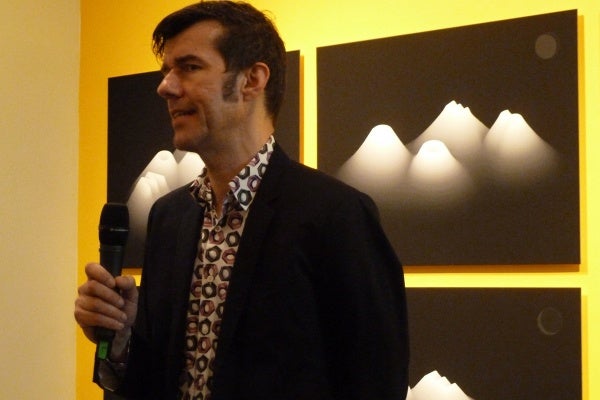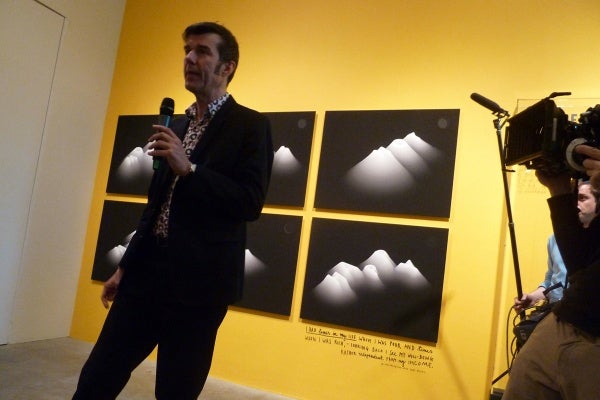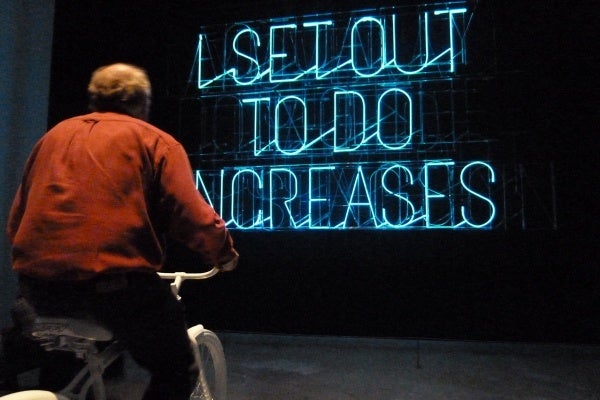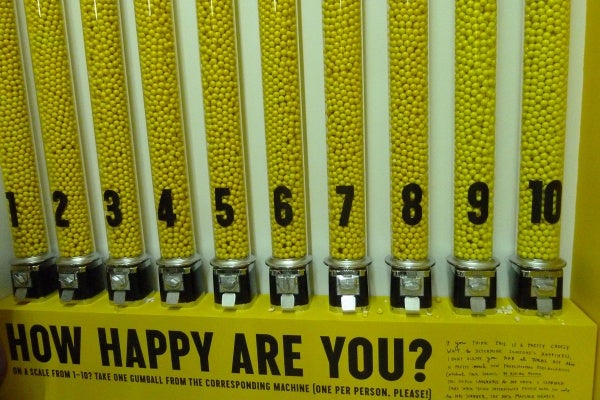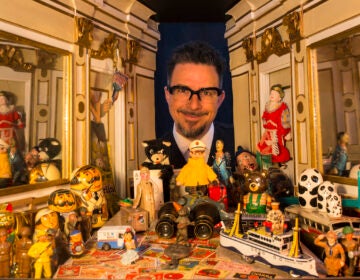‘The Happy Show’ gives prescriptions for the blues
Stefan Sagmeister is an Austrian Grammy-award winning graphic designer, who’s behind album covers for the Talking Heads, Lou Reed, and the Rolling Stones. For the last decade, he’s been exploring happiness – what it means and how to get it. He has a new multimedia exhibit called “The Happy Show” at the Institute of Contemporary Art in West Philadelphia.
One of the first things I learned about happiness from Stefan Sagmeister, is that expecting his show to make you happier turns out to be a faux pas.

“The exhibition itself won’t make people happy. In a similar way, I would say watching a Jane Fonda exercise film won’t make you skinny,” said Sagmeister.
A lot of the exhibit seems like a playground for adults, with enormous inflatable monkeys and a series of silly experiments for you to try. Grace Linden pushes a button and gets a card with a set of instructions.
“Pretend to recognize another guest at the exhibition. Tell them it’s been so long,” reads Linden.
There’s even a bicycle you can pedal to light up huge neon words on the wall. Kevin O’Callaghan is in the saddle.
“Actually doing the things I set out to do — increase my overall level of satisfaction,” said O’Callaghan.
You’d think that Sagmeister might have begun this entire project because he was sad. But no, generally he’s a happy guy. The actual reason goes back to 2009, when Sagmeister was taking a year-long sabbatical in Indonesia and decided to make furniture for his New York studio. When his best friend came to visit,
“He looked around and said if I come back from this year with these seven or eight pieces of furniture, that seems pretty skimpy and not really worth my time,” said Sagmeister.
Sagmeister had already been thinking and speaking for years about how the essential point of design was to make people happy. So he thought, what could be more useful to an audience than finding strategies that really work to increase well-being?
After reading three dozen books on the subject, he turned to psychologist Jonathan Haidt’s “The Happiness Hypothesis,” for three experiments to test for three months each. Stage one: meditation. Every morning, he’d get up at six, light a couple candles, and concentrate hard on breathing for forty-five minutes.
“There were times in the beginning that I thought it was fantastic and just best thing ever,” said Sagmeister. “And sort of surprised why doesn’t everyone do this? And on days where it’s difficult, then it would become pretty boring basically.”
Next was behavioral cognitive therapy, which helped Sagmeister get better at confronting the building manager at his home.
“We have leaks and they don’t tend to get fixed. And it used to take sometimes months,” said Sagmeister. “I think at one time, even years, to get that stuff really done. And this time, I was just better at it, you know, didn’t let him go. He’s quite a bully. And it worked! They actually did get fixed.”
The final stage is taking prescription drugs, which Sagmeister is gearing up to do after he sees a doctor. This whole time, he’s been documenting the experience for a film and monitoring his happiness through mood ratings, MRI brain scans, and diary entries.
“The most surprising thing I’ve learned is I can manufacture a truly happy moment artificially,” he said.
He says all you have to do is take a scooter, a beautiful empty road, an MP3 player with songs that don’t have emotional baggage, and drive around with no purpose.
“Every single time I did it, it created a happy moment beautiful enough that I would have goose bumps with chills running down my spine,” said Sagmeister.
While Sagmeister is still finishing the experiments and film, “The Happy Show” does offer clips and a set of truisms, taken from his diary and spelled out in fantastical typography. Through videos and images, Sagmeister delivers his maxims through levitating sugar cubes, an unraveling spider web, even the body parts of a naked woman.
“I have an addictive personality and tend to overdo most endeavors,” reads Dana Fedeli from a message scrawled on a gallery wall. “When I drank I drank until I was no fun to be around and I had to stop. When I smoke, I inhaled.”
The show may not make you happier, but it certainly makes you pause and forget about the day-to-day. How can you think about your “to do” lists when using a gumball machine to rate your happiness?
“The Happy Show” is open at the Institute of Contemporary Art until August 12th. Stefan Sagmeister’s documentary, “The Happy Film,” will be completed next year.
Photo credit: “Trying to look good limits my life” (right) is one of the works by Stefan Sagmeister showcased in “The Happy Show” at The Institute of Contemporary Art (ICA) at the University of Pennsylvania.
WHYY is your source for fact-based, in-depth journalism and information. As a nonprofit organization, we rely on financial support from readers like you. Please give today.


